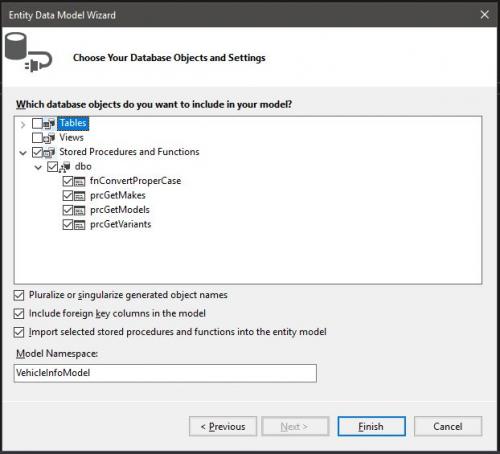uso del procedimiento almacenado en entity framework
Estoy usando asp.net mvc 5 y C# con Entity Framework... Tengo clases de modelo y dominio para la función... ahora necesito usar el procedimiento almacenado.... que estoy luchando en el movimiento.
Estoy siguiendo el código de la primera base de datos existente y he almacenado el procedimiento escrito allí. Mi pregunta es cómo puedo llamar a ese procedimiento almacenado en mi aplicación web.
Procedimiento almacenado:
ALTER PROCEDURE [dbo].[GetFunctionByID](
@FunctionId INT
)
AS
BEGIN
SELECT *
FROM Functions As Fun
WHERE Function_ID = @FunctionId
END
Clase de dominio:
public class Functions
{
public Functions()
{
}
public int Function_ID { get; set; }
public string Title { get; set; }
public int Hierarchy_level { get; set; }
}
Función modelo:
[Table("Functions")]
public class App_Functions
{
public App_Functions()
{
}
[Key]
public int Function_ID { get; set; }
[StringLength(50)]
[Required]
public string Title { get; set; }
public int Hierarchy_level { get; set; }
//public virtual ICollection<App_Controllers> App_Controllers { get; set; }*/
}
Texto base:
public class BaseContext<TContext> : DbContext where TContext : DbContext
{
static BaseContext()
{
Database.SetInitializer<TContext>(null);
}
protected BaseContext()
: base("name = ApplicationDbConnection")
{ }
}
Contexto de la función:
public class FunctionsContext : BaseContext<FunctionsContext>
{
public DbSet<App_Functions> Functions { get; set; }
}
6 answers
Necesita crear una clase de modelo que contenga todas las propiedades de procedimiento almacenadas como se muestra a continuación. Además, debido a que la clase de modelo Entity Framework necesita clave primaria, puede crear una clave falsa utilizando Guid.
public class GetFunctionByID
{
[Key]
public Guid? GetFunctionByID { get; set; }
// All the other properties.
}
Luego registre la clase de modelo GetFunctionByID en su DbContext.
public class FunctionsContext : BaseContext<FunctionsContext>
{
public DbSet<App_Functions> Functions { get; set; }
public DbSet<GetFunctionByID> GetFunctionByIds {get;set;}
}
Cuando llame a su procedimiento almacenado, solo vea a continuación:
var functionId = yourIdParameter;
var result = db.Database.SqlQuery<GetFunctionByID>("GetFunctionByID @FunctionId", new SqlParameter("@FunctionId", functionId)).ToList());
Warning: date(): Invalid date.timezone value 'Europe/Kyiv', we selected the timezone 'UTC' for now. in /var/www/agent_stack/data/www/ajaxhispano.com/template/agent.layouts/content.php on line 61
2014-01-07 14:16:47
Después de importar el procedimiento almacenado, puede crear un objeto de procedimiento almacenado pasar el parámetro como función
using (var entity = new FunctionsContext())
{
var DBdata = entity.GetFunctionByID(5).ToList<Functions>();
}
O también puedes usar SqlQuery
using (var entity = new FunctionsContext())
{
var Parameter = new SqlParameter {
ParameterName = "FunctionId",
Value = 5
};
var DBdata = entity.Database.SqlQuery<Course>("exec GetFunctionByID @FunctionId ", Parameter).ToList<Functions>();
}
Warning: date(): Invalid date.timezone value 'Europe/Kyiv', we selected the timezone 'UTC' for now. in /var/www/agent_stack/data/www/ajaxhispano.com/template/agent.layouts/content.php on line 61
2014-07-08 21:14:12
Puede llamar a un procedimiento almacenado utilizando SqlQuery (Ver aquí)
// Prepare the query
var query = context.Functions.SqlQuery(
"EXEC [dbo].[GetFunctionByID] @p1",
new SqlParameter("p1", 200));
// add NoTracking() if required
// Fetch the results
var result = query.ToList();
Warning: date(): Invalid date.timezone value 'Europe/Kyiv', we selected the timezone 'UTC' for now. in /var/www/agent_stack/data/www/ajaxhispano.com/template/agent.layouts/content.php on line 61
2014-10-20 07:28:28
Mindless passenger tiene un proyecto que le permite llamar a un proc almacenado desde entity frame work como este....
using (testentities te = new testentities())
{
//-------------------------------------------------------------
// Simple stored proc
//-------------------------------------------------------------
var parms1 = new testone() { inparm = "abcd" };
var results1 = te.CallStoredProc<testone>(te.testoneproc, parms1);
var r1 = results1.ToList<TestOneResultSet>();
}
... y estoy trabajando en un framework de procedimientos almacenados (aquí) que se puede llamar como en uno de mis métodos de prueba se muestra a continuación...
[TestClass]
public class TenantDataBasedTests : BaseIntegrationTest
{
[TestMethod]
public void GetTenantForName_ReturnsOneRecord()
{
// ARRANGE
const int expectedCount = 1;
const string expectedName = "Me";
// Build the paraemeters object
var parameters = new GetTenantForTenantNameParameters
{
TenantName = expectedName
};
// get an instance of the stored procedure passing the parameters
var procedure = new GetTenantForTenantNameProcedure(parameters);
// Initialise the procedure name and schema from procedure attributes
procedure.InitializeFromAttributes();
// Add some tenants to context so we have something for the procedure to return!
AddTenentsToContext(Context);
// ACT
// Get the results by calling the stored procedure from the context extention method
var results = Context.ExecuteStoredProcedure(procedure);
// ASSERT
Assert.AreEqual(expectedCount, results.Count);
}
}
internal class GetTenantForTenantNameParameters
{
[Name("TenantName")]
[Size(100)]
[ParameterDbType(SqlDbType.VarChar)]
public string TenantName { get; set; }
}
[Schema("app")]
[Name("Tenant_GetForTenantName")]
internal class GetTenantForTenantNameProcedure
: StoredProcedureBase<TenantResultRow, GetTenantForTenantNameParameters>
{
public GetTenantForTenantNameProcedure(
GetTenantForTenantNameParameters parameters)
: base(parameters)
{
}
}
¿Si alguno de esos dos enfoques es bueno?
Warning: date(): Invalid date.timezone value 'Europe/Kyiv', we selected the timezone 'UTC' for now. in /var/www/agent_stack/data/www/ajaxhispano.com/template/agent.layouts/content.php on line 61
2015-08-30 08:22:48
/ / Agregue algunos inquilinos al contexto para que tengamos algo para que el procedimiento regrese! AddTenentsToContext (Context);
// ACT
// Get the results by calling the stored procedure from the context extention method
var results = Context.ExecuteStoredProcedure(procedure);
// ASSERT
Assert.AreEqual(expectedCount, results.Count);
}
Warning: date(): Invalid date.timezone value 'Europe/Kyiv', we selected the timezone 'UTC' for now. in /var/www/agent_stack/data/www/ajaxhispano.com/template/agent.layouts/content.php on line 61
2015-10-27 10:20:06
Simple. Simplemente instancie su entidad, establézcala en un objeto y pásela a su vista en su controlador.
Entidad
VehicleInfoEntities db = new VehicleInfoEntities();
Procedimiento Almacenado
dbo.prcGetMakes()
o
puede agregar cualquier parámetro en su procedimiento almacenado dentro de los corchetes ()
dbo.prcGetMakes ("BMW")
Controlador
public class HomeController : Controller
{
VehicleInfoEntities db = new VehicleInfoEntities();
public ActionResult Index()
{
var makes = db.prcGetMakes(null);
return View(makes);
}
}
Warning: date(): Invalid date.timezone value 'Europe/Kyiv', we selected the timezone 'UTC' for now. in /var/www/agent_stack/data/www/ajaxhispano.com/template/agent.layouts/content.php on line 61
2018-01-03 21:18:56
